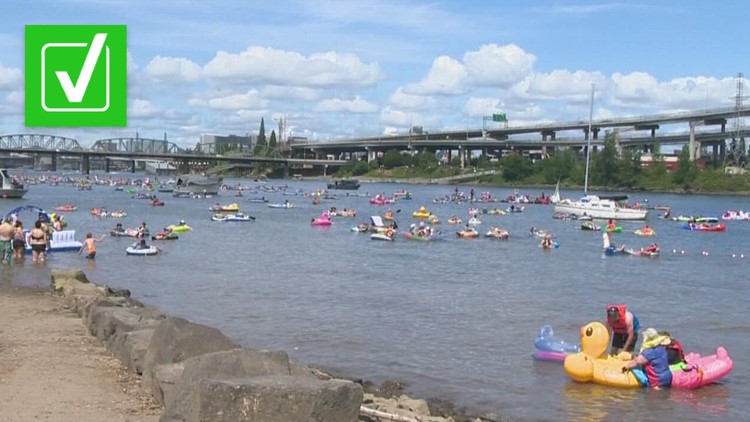PORTLAND, Ore. — After three sewer overflow incidents this past winter, including one round earlier this week, Portland residents could be forgiven for being skeptical about the idea of taking a dip in the city's portion of the Willamette River.
And it's not just the recent incidents; the river has a long and sordid history of sewer infusions, giving rise to an understandable impulse among many Portlanders to avoid it altogether.
But especially in recent years, that perception is bumping up against a growing list of popular swimming spots and special events like the Valentine's Day Dip and the Big Float that regularly draw large crowds into the river.
So is the river safe after all? And why does it have such a stinky reputation? To answer those questions, we turned to the city, the Oregon Department of Environmental Quality and the Human Access Project, a volunteer group that has spent more than a decade working to reconnect Portlanders with the river.
THE QUESTION
In terms of water quality, is it safe to swim in the Willamette River in Portland?
THE SOURCES
THE ANSWER
Yes, it is almost always safe to swim in the Willamette River. Sewer overflows or algae blooms can make it temporarily unsafe, but the City of Portland monitors water quality and will warn the public to stay out until conditions improve.
WHAT WE FOUND
Historically smelly
Not so long ago, staying out of the Willamette was often the smart choice. The river became increasingly contaminated as Portland grew up, and was severely polluted by the 1920s, according to an online historical summary from the Portland Bureau of Environmental Services.
One of the biggest pollution culprits was the city's combined sewer and stormwater system, which funnels residential sewage and rainwater runoff through the same pipes — and in the early years, those pipes dumped it all straight into the river.
The city voted in 1938 to build a sewer interceptor and wastewater treatment system, which together with tougher state regulations and the passage of the federal Clean Water Act led to gradual improvements over the following decades.
But the city's combined sewer and stormwater pipes remained a problem, because while sewage output tends to be relatively consistent, stormwater is highly variable. When the combined volume gets too high, the excess still spills over into the Willamette, carrying some of the sewage into the river.
In a city as rainy as Portland, that's a recipe for frequent sewage contamination. The city used to average 52 sewage overflow incidents per year, often lasting days at a time.
Conditions usually improved during the dry summer months — Human Access Project ringleader Willie Levenson said he's heard of people water skiing on the river as far back as the 1970s — but for many residents, the frequent spills kept the river's reputation sullied year-round.
The Big Pipe
Portland finally began to tackle the overflow problem in 1991 with the Big Pipe project, a 20-year, $1.4 billion undertaking centered on two massive underground pipes that would run along either side of the river, providing excess capacity during storms.
The second pipe came online in 2011, and the impact was immediate. Overflows dropped from an average of 52 per year to about 4 per year since 2011, and they tend to last for hours rather than days.
Willamette River water quality has improved dramatically as a result, and Bureau of Environmental Services, Portland Parks and Recreation and the Oregon Department of Environmental Quality all now agree that the river is generally safe for swimming.
Many other big cities also use combined sewer and stormwater systems and struggle with chronic river contamination, according to BES public information officer Diane Dulken, so the Big Pipe has made Portland a notable success story in efforts to reclaim urban rivers.
There are still some times when Portlanders should stay out of the water — mainly during sewer overflows and algae blooms — but BES and DEQ both monitor the river and issue public warnings if things get hazardous. BES also runs a Big Pipe tracker webpage where people can see sewer levels in real time.
BES tests the river weekly during the summer and monthly during the rest of the year, Dulken said, as well as during and after overflow events to make sure bacteria has dropped back to non-dangerous levels.
Slowly but surely, the perception of the river's cleanliness is changing. Bureau staff have noticed the shift in conversations with the public, Dulken said — people who are newer to Portland tend to be more likely to enjoy the river, while some residents who have lived in the city longer tend to be more reluctant.
Improving public access
A clean river is beneficial to everyone, Dulken said, but it's not the bureau's job to convince people to hop into the water. The Human Access Project stepped in to take on that task, starting right around when the Big Pipe project wrapped up.
One of the group's most prominent efforts is the annual Big Float, which took place every summer for 10 years. The event began as a way to prove and show off the Big Pipe improvements, Levenson said, and to push back against the public perception that the river was terminally toxic.
"That is conventional wisdom for a lot of people," he said. "And that's really where the work of our organization is really cultural change. So when somebody who swims in the river invites a friend to go swim in, there's just one more person who's deputized to be able to give an alternative narrative around the river."
The Big Float went on a hiatus after last summer's event — it's gotten too big for the volunteer organization to coordinate, Levenson said — but the Human Access Project is staying busy with other efforts to improve access to the river.
That's the next big challenge, Levenson explained — in order to enjoy the improved water quality, Portlanders have to be able to physically get into the river, and the Human Access Project is working to create more avenues for that.
That work includes establishing new safe swimming spots along the river, removing concrete and rubble to reclaim beaches and upgrading public facilities at access points like Cathedral Park, he said.
"According to Parks and Recreation, less than 5% of the central city has access to the river's edge," he said. "So that's one of the really big contributing factors as to why we have such a disconnected relationship with the river, but on all fronts, there's lots of progress being made."



